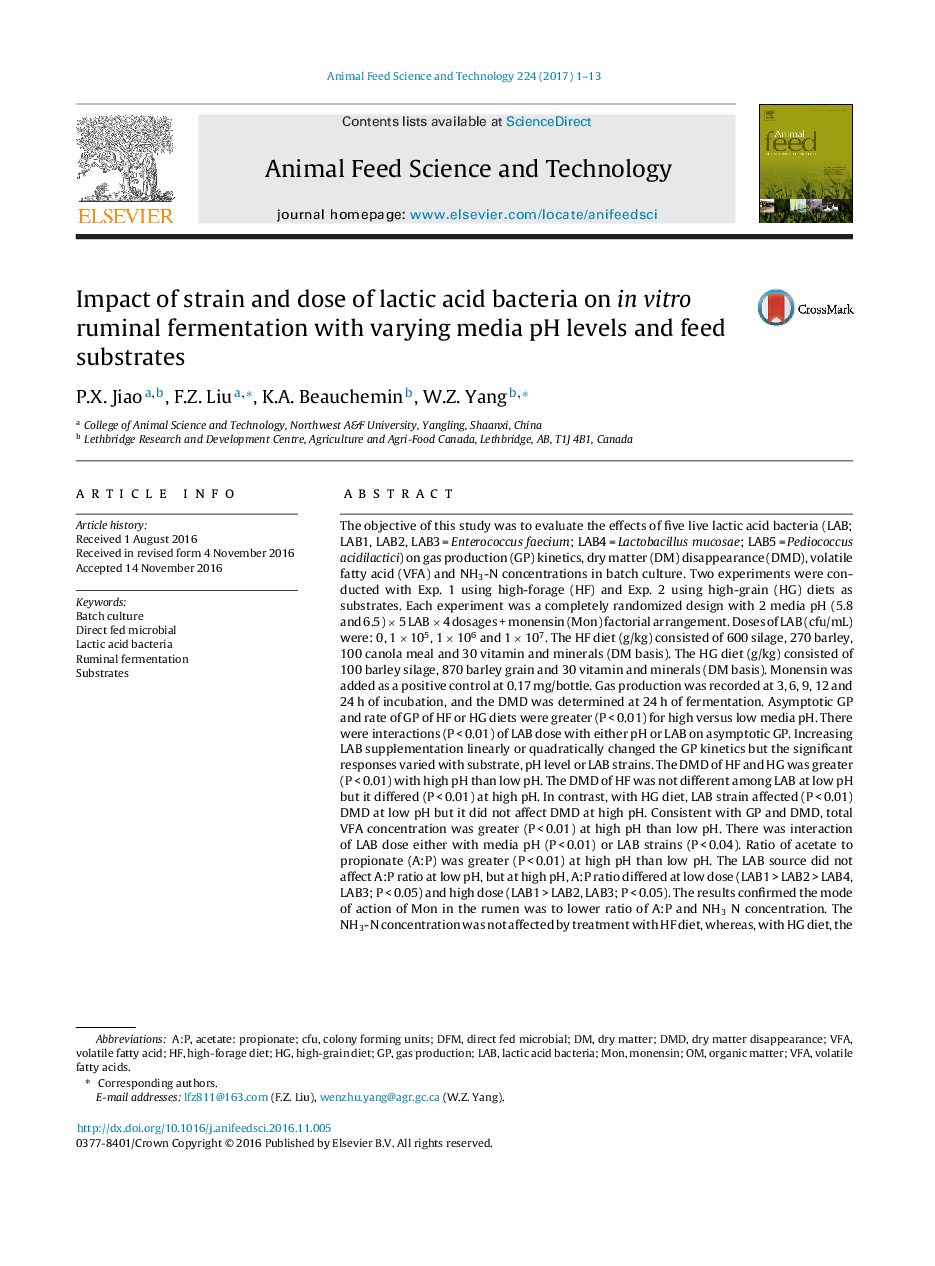| کد مقاله | کد نشریه | سال انتشار | مقاله انگلیسی | نسخه تمام متن |
|---|---|---|---|---|
| 5538778 | 1552362 | 2017 | 13 صفحه PDF | دانلود رایگان |
عنوان انگلیسی مقاله ISI
Impact of strain and dose of lactic acid bacteria on in vitro ruminal fermentation with varying media pH levels and feed substrates
دانلود مقاله + سفارش ترجمه
دانلود مقاله ISI انگلیسی
رایگان برای ایرانیان
کلمات کلیدی
موضوعات مرتبط
علوم زیستی و بیوفناوری
علوم کشاورزی و بیولوژیک
علوم دامی و جانورشناسی
پیش نمایش صفحه اول مقاله

چکیده انگلیسی
The objective of this study was to evaluate the effects of five live lactic acid bacteria (LAB; LAB1, LAB2, LAB3 = Enterococcus faecium; LAB4 = Lactobacillus mucosae; LAB5 = Pediococcus acidilactici) on gas production (GP) kinetics, dry matter (DM) disappearance (DMD), volatile fatty acid (VFA) and NH3-N concentrations in batch culture. Two experiments were conducted with Exp. 1 using high-forage (HF) and Exp. 2 using high-grain (HG) diets as substrates. Each experiment was a completely randomized design with 2 media pH (5.8 and 6.5) Ã 5 LAB Ã 4 dosages + monensin (Mon) factorial arrangement. Doses of LAB (cfu/mL) were: 0, 1 Ã 105, 1 Ã 106 and 1 Ã 107. The HF diet (g/kg) consisted of 600 silage, 270 barley, 100 canola meal and 30 vitamin and minerals (DM basis). The HG diet (g/kg) consisted of 100 barley silage, 870 barley grain and 30 vitamin and minerals (DM basis). Monensin was added as a positive control at 0.17 mg/bottle. Gas production was recorded at 3, 6, 9, 12 and 24 h of incubation, and the DMD was determined at 24 h of fermentation. Asymptotic GP and rate of GP of HF or HG diets were greater (P < 0.01) for high versus low media pH. There were interactions (P < 0.01) of LAB dose with either pH or LAB on asymptotic GP. Increasing LAB supplementation linearly or quadratically changed the GP kinetics but the significant responses varied with substrate, pH level or LAB strains. The DMD of HF and HG was greater (P < 0.01) with high pH than low pH. The DMD of HF was not different among LAB at low pH but it differed (P < 0.01) at high pH. In contrast, with HG diet, LAB strain affected (P < 0.01) DMD at low pH but it did not affect DMD at high pH. Consistent with GP and DMD, total VFA concentration was greater (P < 0.01) at high pH than low pH. There was interaction of LAB dose either with media pH (P < 0.01) or LAB strains (P < 0.04). Ratio of acetate to propionate (A:P) was greater (P < 0.01) at high pH than low pH. The LAB source did not affect A:P ratio at low pH, but at high pH, A:P ratio differed at low dose (LAB1 > LAB2 > LAB4, LAB3; P < 0.05) and high dose (LAB1 > LAB2, LAB3; P < 0.05). The results confirmed the mode of action of Mon in the rumen was to lower ratio of A:P and NH3 N concentration. The NH3-N concentration was not affected by treatment with HF diet, whereas, with HG diet, the NH3-N concentration varied with media pH, LAB or the dose of LAB. These results indicate that the effect of LAB on rumen fermentation depended on media pH, strain and dose of LAB or substrate incubated. The LAB3 (E. faecium) could be a better candidate for improving feed digestion in the rumen with HF diet. The differences between LAB and Mon suggest different mode of action in the rumen.
ناشر
Database: Elsevier - ScienceDirect (ساینس دایرکت)
Journal: Animal Feed Science and Technology - Volume 224, February 2017, Pages 1-13
Journal: Animal Feed Science and Technology - Volume 224, February 2017, Pages 1-13
نویسندگان
P.X. Jiao, F.Z. Liu, K.A. Beauchemin, W.Z. Yang,